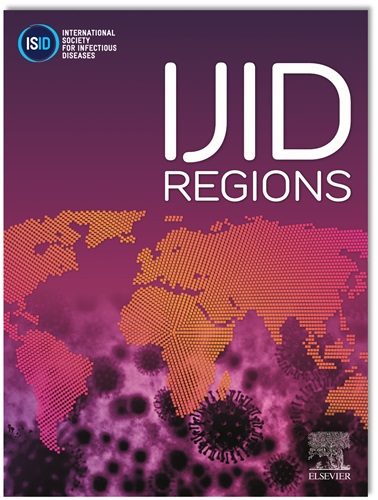Microbiology and long-term outcomes in community-acquired, nosocomial and post-neurosurgical meningitis with positive bacterial culture in Ontario, Canada: A population-based cohort study
IF 4.8
2区 医学
Q1 INFECTIOUS DISEASES
引用次数: 0
Abstract
Background
Bacterial meningitis is a rare but severe infection that has a high risk of mortality and morbidity. The study objective was to describe the microbiology, long-term mortality risk, and complications from neurologic sequelae for bacterial meningitis.
Methods
This retrospective cohort study included adults with a positive cerebrospinal fluid (CSF) bacterial culture collected from 2014 to 2022 inclusive in Ontario, Canada. Patients were followed for 1 year. The primary outcome was all-cause mortality. Secondary outcomes included aspiration, enteral feeding tube insertion, decubitus ulcers, falls and/or fractures, and long-term care admissions.
Results
856(2.1%) patients had positive CSF cultures including 431(50.4%) community-acquired, 255 (29.8%) nosocomial and 170(19.9%) post-neurosurgical meningitis cases. Staphylococcus aureus was the second most common pathogen in community-acquired meningitis (10.9%) and the most common pathogen in nosocomial (11.8%) and post-neurosurgical (22.9%) meningitis. All-cause mortality at 30, 90, 180, and 365 days were 11.4%, 13.2%, 14.8% and 16.5% for community-acquired meningitis; 16.5%, 22.4%, 25.1% and 27.1% for nosocomial meningitis; and 10.6%, 20.0%, 25.9% and 28.8% for postneurosurgical meningitis. Enteral feeding tube was inserted in 2.8%, 15.3%, and 20.0% of community-acquired, nosocomial, and post-neurosurgical meningitis cases respectively. Other secondary outcomes occurred rarely.
Conclusion
S. aureus was an important pathogen. Meningitis mortality continued to increase over 1 year. For nosocomial and post-neurosurgical meningitis, one in four died by 1 year and many required enteral feeding tube.
微生物学和加拿大安大略省社区获得性、医院性和术后神经外科脑膜炎细菌培养阳性患者的长期预后:一项基于人群的队列研究。
背景:细菌性脑膜炎是一种罕见但严重的感染,具有很高的死亡率和发病率。研究目的是描述细菌性脑膜炎的微生物学、长期死亡风险和神经系统后遗症并发症。方法:这项回顾性队列研究纳入了2014年至2022年(含2022年)在加拿大安大略省采集的脑脊液(CSF)细菌培养阳性的成年人。随访1年。主要结局为全因死亡率。次要结局包括误吸、肠内喂食管插入、褥疮溃疡、跌倒和/或骨折以及长期护理入院。结果:脑脊液培养阳性856例(2.1%),其中社区获得性脑膜炎431例(50.4%),医院获得性脑膜炎255例(29.8%),术后脑脊液脑膜炎170例(19.9%)。金黄色葡萄球菌是社区获得性脑膜炎的第二常见病原体(10.9%),医院源性脑膜炎(11.8%)和神经外科后脑膜炎(22.9%)的最常见病原体。社区获得性脑膜炎30、90、180和365天的全因死亡率分别为11.4%、13.2%、14.8%和16.5%;医院源性脑膜炎分别为16.5%、22.4%、25.1%和27.1%;神经外科术后脑膜炎发生率分别为10.6%、20.0%、25.9%和28.8%。社区获得性脑膜炎、医院获得性脑膜炎和神经外科术后脑膜炎分别占2.8%、15.3%和20.0%。其他次要结果很少发生。结论:金黄色葡萄球菌是重要的病原菌。脑膜炎死亡率在一年内继续上升。对于院内和神经外科术后的脑膜炎,1 / 4的人在1年内死亡,许多人需要肠内喂养管。
本文章由计算机程序翻译,如有差异,请以英文原文为准。
求助全文
约1分钟内获得全文
求助全文
来源期刊
CiteScore
18.90
自引率
2.40%
发文量
1020
审稿时长
30 days
期刊介绍:
International Journal of Infectious Diseases (IJID)
Publisher: International Society for Infectious Diseases
Publication Frequency: Monthly
Type: Peer-reviewed, Open Access
Scope:
Publishes original clinical and laboratory-based research.
Reports clinical trials, reviews, and some case reports.
Focuses on epidemiology, clinical diagnosis, treatment, and control of infectious diseases.
Emphasizes diseases common in under-resourced countries.

 求助内容:
求助内容: 应助结果提醒方式:
应助结果提醒方式:


